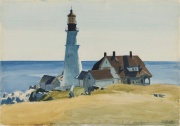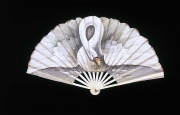Difference between revisions of "Watercolor paint"
m (Text replace - "== Authority ==" to "== Sources Checked for Data in Record ==") |
|||
| Line 1: | Line 1: | ||
| − | [[File:48.723-SC73660.jpg|thumb| | + | [[File:48.723-SC73660.jpg|thumb|Maine lighthouse by Hopper<br>MFA Acc. #: 48.723]] |
== Description == | == Description == | ||
A transparent or opaque paint with an aqueous binding medium. Most watercolor paints contain [[gum arabic]] as a binder. Aqueous based paints made with vegetable gum binders were used by Egyptian, Greek, and Roman artists for wall paintings. Japanese and Chinese painters extensively used watercolor paints on [[silk]] and paper supports. In the 16th-18th century, watercolor paints were used for miniature illustrations on [[porcelain]], [[ivory]], cards, books and manuscripts. By the 18th and early 19 centuries, watercolors rapidly increased in popularity due to the availability of small cakes of watercolor paints in metal pans. Water-based paints often contain additives such as plasticizers ([[hydromel]], [[glycerin]]), wetting agents ([[oxgall]], [[surfactant]]) and preservatives ([[phenol]], [[alcohol]]). | A transparent or opaque paint with an aqueous binding medium. Most watercolor paints contain [[gum arabic]] as a binder. Aqueous based paints made with vegetable gum binders were used by Egyptian, Greek, and Roman artists for wall paintings. Japanese and Chinese painters extensively used watercolor paints on [[silk]] and paper supports. In the 16th-18th century, watercolor paints were used for miniature illustrations on [[porcelain]], [[ivory]], cards, books and manuscripts. By the 18th and early 19 centuries, watercolors rapidly increased in popularity due to the availability of small cakes of watercolor paints in metal pans. Water-based paints often contain additives such as plasticizers ([[hydromel]], [[glycerin]]), wetting agents ([[oxgall]], [[surfactant]]) and preservatives ([[phenol]], [[alcohol]]). | ||
| − | [[File:53.2179-172-49.jpg|thumb| | + | [[File:53.2179-172-49.jpg|thumb|Folding fan<br>MFA Acc. #: 53.2179]] |
== Synonyms and Related Terms == | == Synonyms and Related Terms == | ||
| Line 21: | Line 21: | ||
| − | == | + | == Resources and Citations == |
* Reed Kay, ''The Painter's Guide To Studio Methods and Materials'', Prentice-Hall, Inc., Englewood Cliffs, NJ, 1983 | * Reed Kay, ''The Painter's Guide To Studio Methods and Materials'', Prentice-Hall, Inc., Englewood Cliffs, NJ, 1983 | ||
Latest revision as of 11:30, 15 August 2020
Description
A transparent or opaque paint with an aqueous binding medium. Most watercolor paints contain Gum arabic as a binder. Aqueous based paints made with vegetable gum binders were used by Egyptian, Greek, and Roman artists for wall paintings. Japanese and Chinese painters extensively used watercolor paints on Silk and paper supports. In the 16th-18th century, watercolor paints were used for miniature illustrations on Porcelain, Ivory, cards, books and manuscripts. By the 18th and early 19 centuries, watercolors rapidly increased in popularity due to the availability of small cakes of watercolor paints in metal pans. Water-based paints often contain additives such as plasticizers (Hydromel, Glycerin), wetting agents (Oxgall, Surfactant) and preservatives (Phenol, Alcohol).
Synonyms and Related Terms
watercolors ; watermedia; water color paint; water-colour paint (Br.); aquarelle (Fr.); akvarel (Dan.); Aquarell (Deut.); acuarela (Esp.); acquerello (It.); aquarel (Ned.); akvarell (Nor., Sven.); akwarela (Pol.); aguarela (Port.); tinta de aguarela (Port.)
Additional Images
Resources and Citations
- Reed Kay, The Painter's Guide To Studio Methods and Materials, Prentice-Hall, Inc., Englewood Cliffs, NJ, 1983
- Ralph Mayer, A Dictionary of Art Terms and Techniques, Harper and Row Publishers, New York, 1969 (also 1945 printing)
- Hermann Kuhn, Conservation and Restoration of Works of Art and Antiquities, Butterworths, London, 1986
- Matt Roberts, Don Etherington, Bookbinding and the Conservation of Books: a Dictionary of Descriptive Terminology, U.S. Government Printing Office, Washington DC, 1982
- Dictionary of Building Preservation, Ward Bucher, ed., John Wiley & Sons, Inc., New York City, 1996
- Random House, Webster's Encyclopedic Unabridged Dictionary of the English Language, Grammercy Book, New York, 1997
- The American Heritage Dictionary or Encarta, via Microsoft Bookshelf 98, Microsoft Corp., 1998
- Website address 1 Comment: D. van der Reyden "Identifying the Real Thing" www.scmre.org/analysis.htm
- Art and Architecture Thesaurus Online, http://www.getty.edu/research/tools/vocabulary/aat/, J. Paul Getty Trust, Los Angeles, 2000






